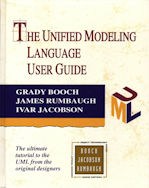Introduced in 1997, the Unified Modeling Language (UML)
has rapidly been accepted throughout the software industry
as the standard graphical language for specifying, constructing,
visualizing, and documenting software-intensive systems.
The UML provides anyone involved in the production, deployment,
and maintenance of software with a standard notation for expressing a system’s blueprint.
The UML covers conceptual things, such as business processes and system functions,
as well as concrete things, such as programming-language classes, database schemas,
and reusable software components.
In The Unified Modeling Language User Guide, the original developers of the UML—Grady
Booch, James Rumbaugh, and Ivar Jacobson—provide a tutorial to the core aspects
of the language in a two-color format designed to facilitate learning.
Starting with a conceptual model of the UML,
the book progressively applies the UML to a series of increasingly complex modeling problems
across a variety of application domains.
This example-driven approach helps readers quickly understand and apply the UML.
For more advanced developers, the book includes a learning track focused on applying
the UML to advanced modeling problems.
With The Unified Modeling Language User Guide, readers will:
• understand what the UML is, what it is not,
and why it is relevant to the development of software-intensive systems
• master the vocabulary, rules, and idioms of the UML in order
to “speak” the language effectively
• learn how to apply the UML to a number of common modeling problems
• see illustrations of the UML’s use interspersed with use cases for specific UML features
• gain insight into the UML from the original designers of the UML
